Always Precise Instruments (API) Audit Risks Discussion Memo
VerifiedAdded on 2023/03/20
|13
|3341
|63
Report
AI Summary
This report, presented as a memo to the audit manager, analyzes the audit risks associated with Always Precise Instruments Pty Limited (API). It examines the company's financial statements, focusing on ratio analysis and internal control procedures related to inventory. The report highlights potential audit risks, including those revealed through key ratios like the current ratio, return on equity, quick asset ratio, return on total assets, gross margin, marketing expenses, administration expenses, times interest earned, days in inventory, days in receivables, and debt-to-equity ratio. Furthermore, the memo discusses weaknesses in internal control for inventory management and their associated audit risks. The analysis includes audit procedures and sampling tests, aiming to identify potential material misstatements in API's financial reporting. The memo concludes by emphasizing the importance of effective audit procedures to ensure the accuracy and fairness of the financial statements.

Running head: AUDITING
Auditing
Name of the Student:
Name of the University:
Author’s Note:
Auditing
Name of the Student:
Name of the University:
Author’s Note:
Paraphrase This Document
Need a fresh take? Get an instant paraphrase of this document with our AI Paraphraser
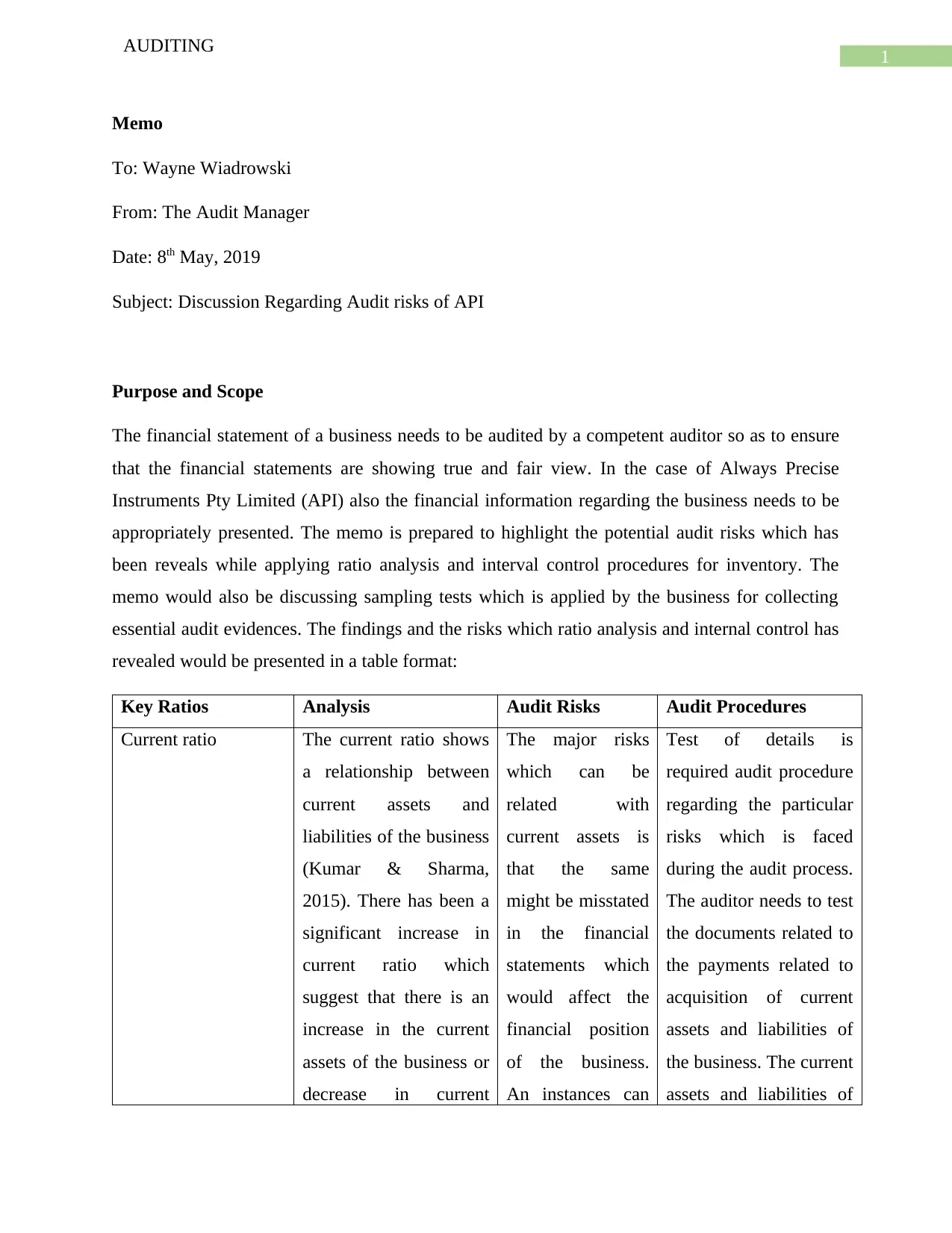
1
AUDITING
Memo
To: Wayne Wiadrowski
From: The Audit Manager
Date: 8th May, 2019
Subject: Discussion Regarding Audit risks of API
Purpose and Scope
The financial statement of a business needs to be audited by a competent auditor so as to ensure
that the financial statements are showing true and fair view. In the case of Always Precise
Instruments Pty Limited (API) also the financial information regarding the business needs to be
appropriately presented. The memo is prepared to highlight the potential audit risks which has
been reveals while applying ratio analysis and interval control procedures for inventory. The
memo would also be discussing sampling tests which is applied by the business for collecting
essential audit evidences. The findings and the risks which ratio analysis and internal control has
revealed would be presented in a table format:
Key Ratios Analysis Audit Risks Audit Procedures
Current ratio The current ratio shows
a relationship between
current assets and
liabilities of the business
(Kumar & Sharma,
2015). There has been a
significant increase in
current ratio which
suggest that there is an
increase in the current
assets of the business or
decrease in current
The major risks
which can be
related with
current assets is
that the same
might be misstated
in the financial
statements which
would affect the
financial position
of the business.
An instances can
Test of details is
required audit procedure
regarding the particular
risks which is faced
during the audit process.
The auditor needs to test
the documents related to
the payments related to
acquisition of current
assets and liabilities of
the business. The current
assets and liabilities of
AUDITING
Memo
To: Wayne Wiadrowski
From: The Audit Manager
Date: 8th May, 2019
Subject: Discussion Regarding Audit risks of API
Purpose and Scope
The financial statement of a business needs to be audited by a competent auditor so as to ensure
that the financial statements are showing true and fair view. In the case of Always Precise
Instruments Pty Limited (API) also the financial information regarding the business needs to be
appropriately presented. The memo is prepared to highlight the potential audit risks which has
been reveals while applying ratio analysis and interval control procedures for inventory. The
memo would also be discussing sampling tests which is applied by the business for collecting
essential audit evidences. The findings and the risks which ratio analysis and internal control has
revealed would be presented in a table format:
Key Ratios Analysis Audit Risks Audit Procedures
Current ratio The current ratio shows
a relationship between
current assets and
liabilities of the business
(Kumar & Sharma,
2015). There has been a
significant increase in
current ratio which
suggest that there is an
increase in the current
assets of the business or
decrease in current
The major risks
which can be
related with
current assets is
that the same
might be misstated
in the financial
statements which
would affect the
financial position
of the business.
An instances can
Test of details is
required audit procedure
regarding the particular
risks which is faced
during the audit process.
The auditor needs to test
the documents related to
the payments related to
acquisition of current
assets and liabilities of
the business. The current
assets and liabilities of

2
AUDITING
liabilities of the
business.
be provided of a
company which
would try to
coverup its
liquidity crisis by
portraying
favourable current
ratio.
the business needs to be
appropriately presented
in the annual reports of
the business.
Return on Equity The ratio analysis shows
that there is a slight
decrease in this asset for
the year 2018 and the
estimate is even lower
than industry
benchmark. This is
mainly due to fall in the
profits of the business
which has resulted in
fall in returns available
to equity shareholders.
Any misstatement
in the profit and
loss account can
affect the profits
of the business and
lead to variances
in the ratio.
Similarly, a
decrease or
misstatement
associated with
equity capital can
also affect the
ratio.
Test of details is
associated with the
accurate audit procedure
which is applied by the
auditor for assessing
whether there is any
material misstatement or
not. The auditor of the
business also needs to
check the books of
accounts and all other
relevant document in a
detailed manner so that
the same are accurately
represented (Peytcheva,
Wright & Majoor,
2014). A proper scrutiny
of the above documents
would reduce the risks
considerably.
Quick Asset Ratio The estimate which is
demonstrated in the
analysis shows an
The potential audit
risk which can be
identified is
The auditor of the
business needs to apply
test of details and test of
AUDITING
liabilities of the
business.
be provided of a
company which
would try to
coverup its
liquidity crisis by
portraying
favourable current
ratio.
the business needs to be
appropriately presented
in the annual reports of
the business.
Return on Equity The ratio analysis shows
that there is a slight
decrease in this asset for
the year 2018 and the
estimate is even lower
than industry
benchmark. This is
mainly due to fall in the
profits of the business
which has resulted in
fall in returns available
to equity shareholders.
Any misstatement
in the profit and
loss account can
affect the profits
of the business and
lead to variances
in the ratio.
Similarly, a
decrease or
misstatement
associated with
equity capital can
also affect the
ratio.
Test of details is
associated with the
accurate audit procedure
which is applied by the
auditor for assessing
whether there is any
material misstatement or
not. The auditor of the
business also needs to
check the books of
accounts and all other
relevant document in a
detailed manner so that
the same are accurately
represented (Peytcheva,
Wright & Majoor,
2014). A proper scrutiny
of the above documents
would reduce the risks
considerably.
Quick Asset Ratio The estimate which is
demonstrated in the
analysis shows an
The potential audit
risk which can be
identified is
The auditor of the
business needs to apply
test of details and test of
⊘ This is a preview!⊘
Do you want full access?
Subscribe today to unlock all pages.

Trusted by 1+ million students worldwide
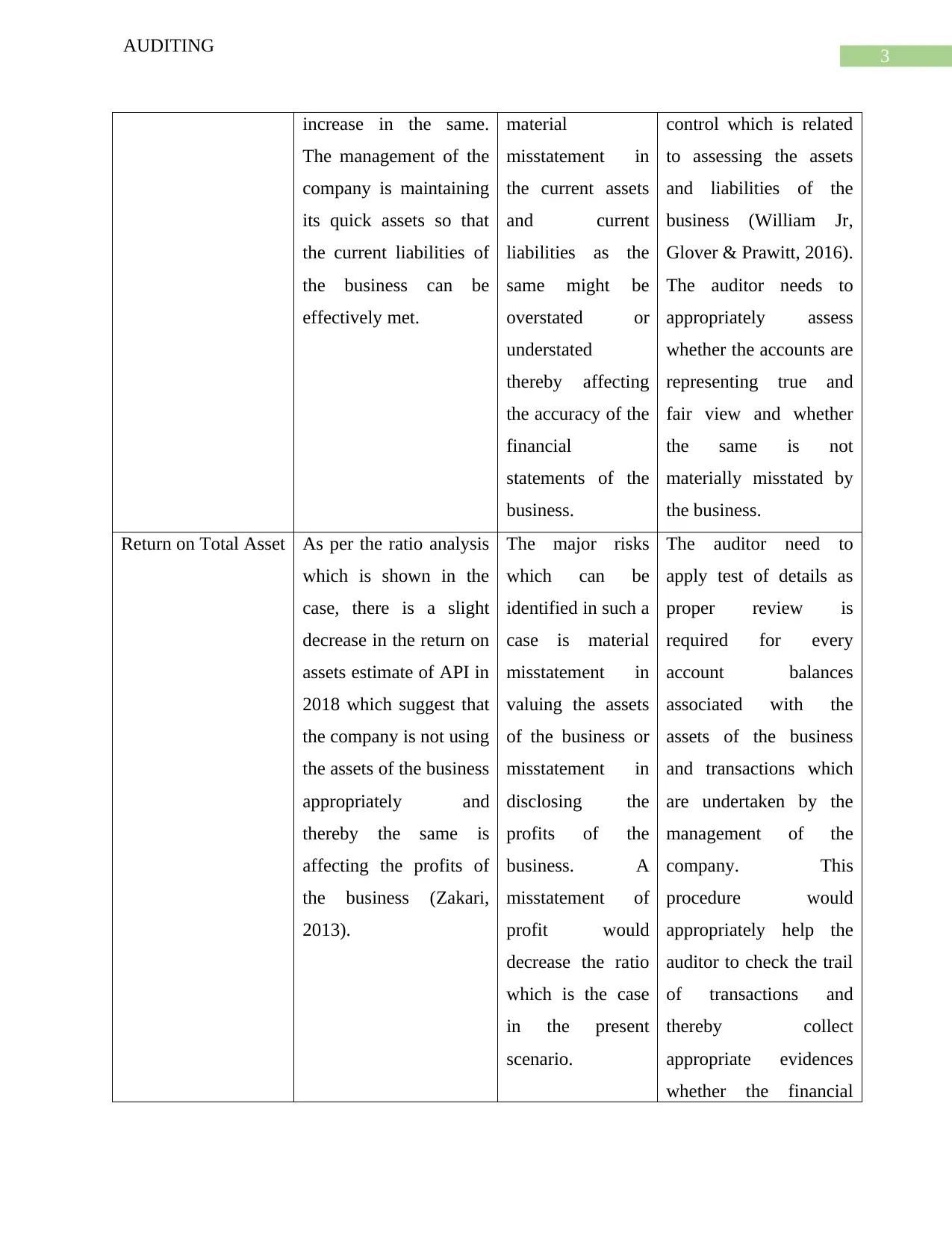
3
AUDITING
increase in the same.
The management of the
company is maintaining
its quick assets so that
the current liabilities of
the business can be
effectively met.
material
misstatement in
the current assets
and current
liabilities as the
same might be
overstated or
understated
thereby affecting
the accuracy of the
financial
statements of the
business.
control which is related
to assessing the assets
and liabilities of the
business (William Jr,
Glover & Prawitt, 2016).
The auditor needs to
appropriately assess
whether the accounts are
representing true and
fair view and whether
the same is not
materially misstated by
the business.
Return on Total Asset As per the ratio analysis
which is shown in the
case, there is a slight
decrease in the return on
assets estimate of API in
2018 which suggest that
the company is not using
the assets of the business
appropriately and
thereby the same is
affecting the profits of
the business (Zakari,
2013).
The major risks
which can be
identified in such a
case is material
misstatement in
valuing the assets
of the business or
misstatement in
disclosing the
profits of the
business. A
misstatement of
profit would
decrease the ratio
which is the case
in the present
scenario.
The auditor need to
apply test of details as
proper review is
required for every
account balances
associated with the
assets of the business
and transactions which
are undertaken by the
management of the
company. This
procedure would
appropriately help the
auditor to check the trail
of transactions and
thereby collect
appropriate evidences
whether the financial
AUDITING
increase in the same.
The management of the
company is maintaining
its quick assets so that
the current liabilities of
the business can be
effectively met.
material
misstatement in
the current assets
and current
liabilities as the
same might be
overstated or
understated
thereby affecting
the accuracy of the
financial
statements of the
business.
control which is related
to assessing the assets
and liabilities of the
business (William Jr,
Glover & Prawitt, 2016).
The auditor needs to
appropriately assess
whether the accounts are
representing true and
fair view and whether
the same is not
materially misstated by
the business.
Return on Total Asset As per the ratio analysis
which is shown in the
case, there is a slight
decrease in the return on
assets estimate of API in
2018 which suggest that
the company is not using
the assets of the business
appropriately and
thereby the same is
affecting the profits of
the business (Zakari,
2013).
The major risks
which can be
identified in such a
case is material
misstatement in
valuing the assets
of the business or
misstatement in
disclosing the
profits of the
business. A
misstatement of
profit would
decrease the ratio
which is the case
in the present
scenario.
The auditor need to
apply test of details as
proper review is
required for every
account balances
associated with the
assets of the business
and transactions which
are undertaken by the
management of the
company. This
procedure would
appropriately help the
auditor to check the trail
of transactions and
thereby collect
appropriate evidences
whether the financial
Paraphrase This Document
Need a fresh take? Get an instant paraphrase of this document with our AI Paraphraser
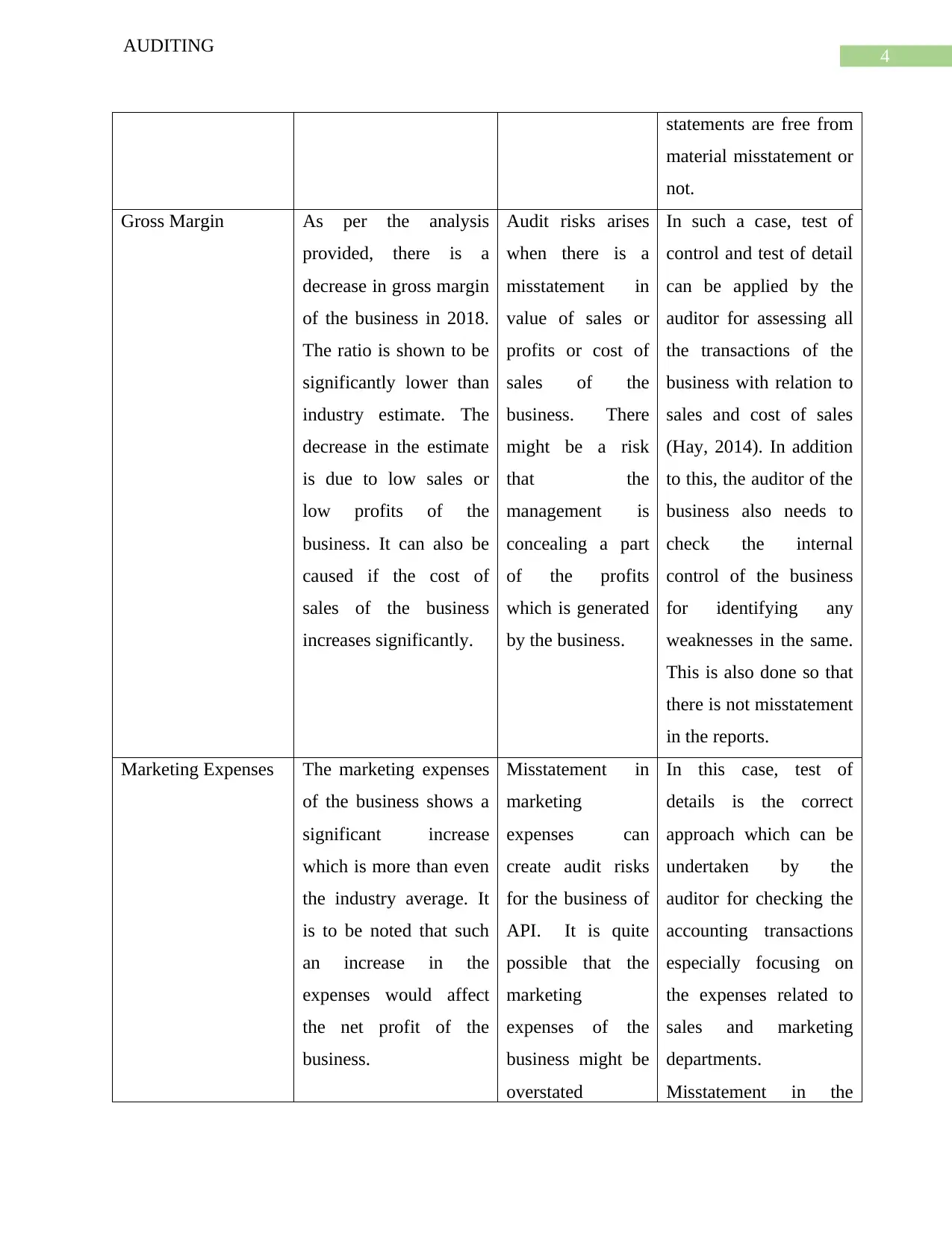
4
AUDITING
statements are free from
material misstatement or
not.
Gross Margin As per the analysis
provided, there is a
decrease in gross margin
of the business in 2018.
The ratio is shown to be
significantly lower than
industry estimate. The
decrease in the estimate
is due to low sales or
low profits of the
business. It can also be
caused if the cost of
sales of the business
increases significantly.
Audit risks arises
when there is a
misstatement in
value of sales or
profits or cost of
sales of the
business. There
might be a risk
that the
management is
concealing a part
of the profits
which is generated
by the business.
In such a case, test of
control and test of detail
can be applied by the
auditor for assessing all
the transactions of the
business with relation to
sales and cost of sales
(Hay, 2014). In addition
to this, the auditor of the
business also needs to
check the internal
control of the business
for identifying any
weaknesses in the same.
This is also done so that
there is not misstatement
in the reports.
Marketing Expenses The marketing expenses
of the business shows a
significant increase
which is more than even
the industry average. It
is to be noted that such
an increase in the
expenses would affect
the net profit of the
business.
Misstatement in
marketing
expenses can
create audit risks
for the business of
API. It is quite
possible that the
marketing
expenses of the
business might be
overstated
In this case, test of
details is the correct
approach which can be
undertaken by the
auditor for checking the
accounting transactions
especially focusing on
the expenses related to
sales and marketing
departments.
Misstatement in the
AUDITING
statements are free from
material misstatement or
not.
Gross Margin As per the analysis
provided, there is a
decrease in gross margin
of the business in 2018.
The ratio is shown to be
significantly lower than
industry estimate. The
decrease in the estimate
is due to low sales or
low profits of the
business. It can also be
caused if the cost of
sales of the business
increases significantly.
Audit risks arises
when there is a
misstatement in
value of sales or
profits or cost of
sales of the
business. There
might be a risk
that the
management is
concealing a part
of the profits
which is generated
by the business.
In such a case, test of
control and test of detail
can be applied by the
auditor for assessing all
the transactions of the
business with relation to
sales and cost of sales
(Hay, 2014). In addition
to this, the auditor of the
business also needs to
check the internal
control of the business
for identifying any
weaknesses in the same.
This is also done so that
there is not misstatement
in the reports.
Marketing Expenses The marketing expenses
of the business shows a
significant increase
which is more than even
the industry average. It
is to be noted that such
an increase in the
expenses would affect
the net profit of the
business.
Misstatement in
marketing
expenses can
create audit risks
for the business of
API. It is quite
possible that the
marketing
expenses of the
business might be
overstated
In this case, test of
details is the correct
approach which can be
undertaken by the
auditor for checking the
accounting transactions
especially focusing on
the expenses related to
sales and marketing
departments.
Misstatement in the
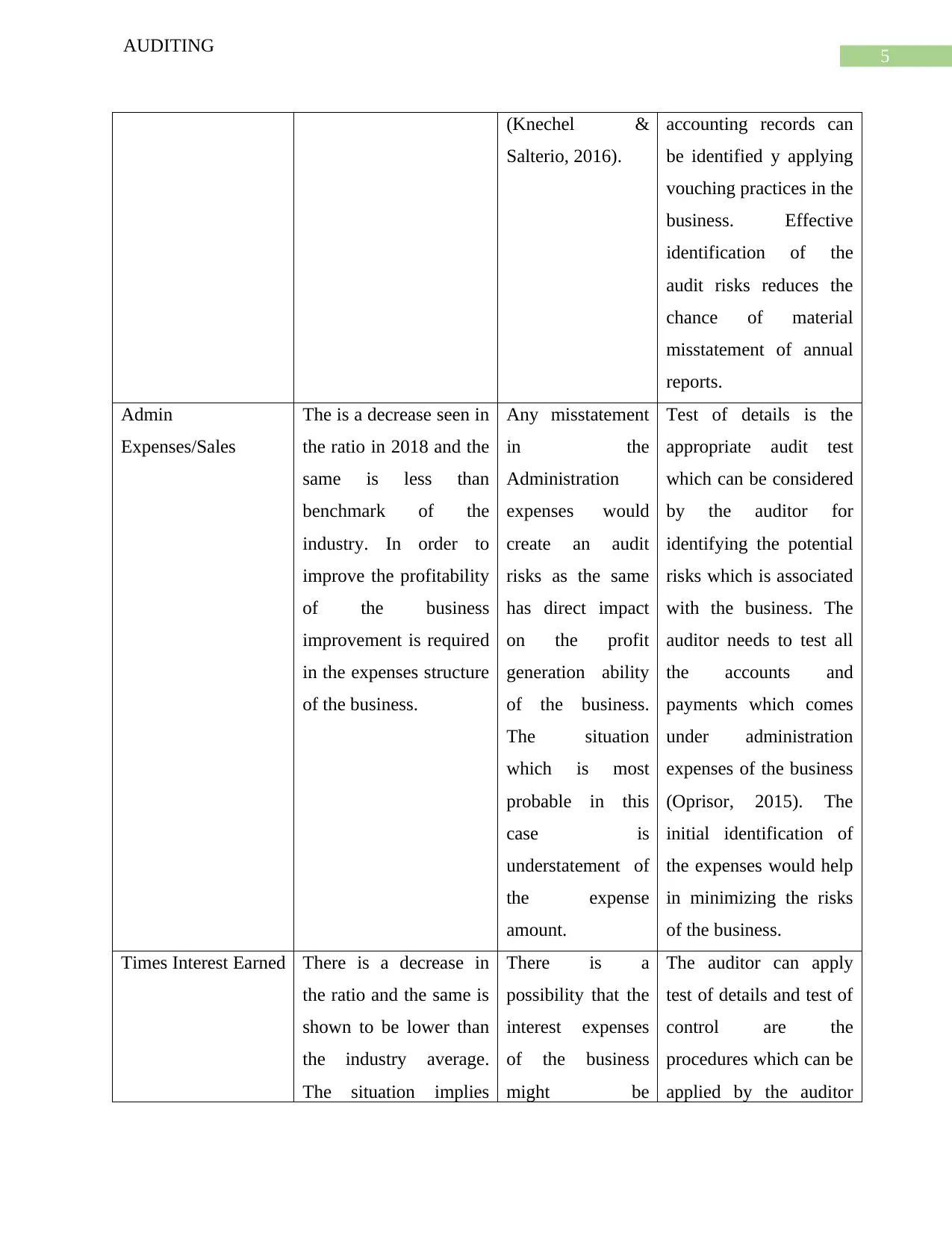
5
AUDITING
(Knechel &
Salterio, 2016).
accounting records can
be identified y applying
vouching practices in the
business. Effective
identification of the
audit risks reduces the
chance of material
misstatement of annual
reports.
Admin
Expenses/Sales
The is a decrease seen in
the ratio in 2018 and the
same is less than
benchmark of the
industry. In order to
improve the profitability
of the business
improvement is required
in the expenses structure
of the business.
Any misstatement
in the
Administration
expenses would
create an audit
risks as the same
has direct impact
on the profit
generation ability
of the business.
The situation
which is most
probable in this
case is
understatement of
the expense
amount.
Test of details is the
appropriate audit test
which can be considered
by the auditor for
identifying the potential
risks which is associated
with the business. The
auditor needs to test all
the accounts and
payments which comes
under administration
expenses of the business
(Oprisor, 2015). The
initial identification of
the expenses would help
in minimizing the risks
of the business.
Times Interest Earned There is a decrease in
the ratio and the same is
shown to be lower than
the industry average.
The situation implies
There is a
possibility that the
interest expenses
of the business
might be
The auditor can apply
test of details and test of
control are the
procedures which can be
applied by the auditor
AUDITING
(Knechel &
Salterio, 2016).
accounting records can
be identified y applying
vouching practices in the
business. Effective
identification of the
audit risks reduces the
chance of material
misstatement of annual
reports.
Admin
Expenses/Sales
The is a decrease seen in
the ratio in 2018 and the
same is less than
benchmark of the
industry. In order to
improve the profitability
of the business
improvement is required
in the expenses structure
of the business.
Any misstatement
in the
Administration
expenses would
create an audit
risks as the same
has direct impact
on the profit
generation ability
of the business.
The situation
which is most
probable in this
case is
understatement of
the expense
amount.
Test of details is the
appropriate audit test
which can be considered
by the auditor for
identifying the potential
risks which is associated
with the business. The
auditor needs to test all
the accounts and
payments which comes
under administration
expenses of the business
(Oprisor, 2015). The
initial identification of
the expenses would help
in minimizing the risks
of the business.
Times Interest Earned There is a decrease in
the ratio and the same is
shown to be lower than
the industry average.
The situation implies
There is a
possibility that the
interest expenses
of the business
might be
The auditor can apply
test of details and test of
control are the
procedures which can be
applied by the auditor
⊘ This is a preview!⊘
Do you want full access?
Subscribe today to unlock all pages.

Trusted by 1+ million students worldwide
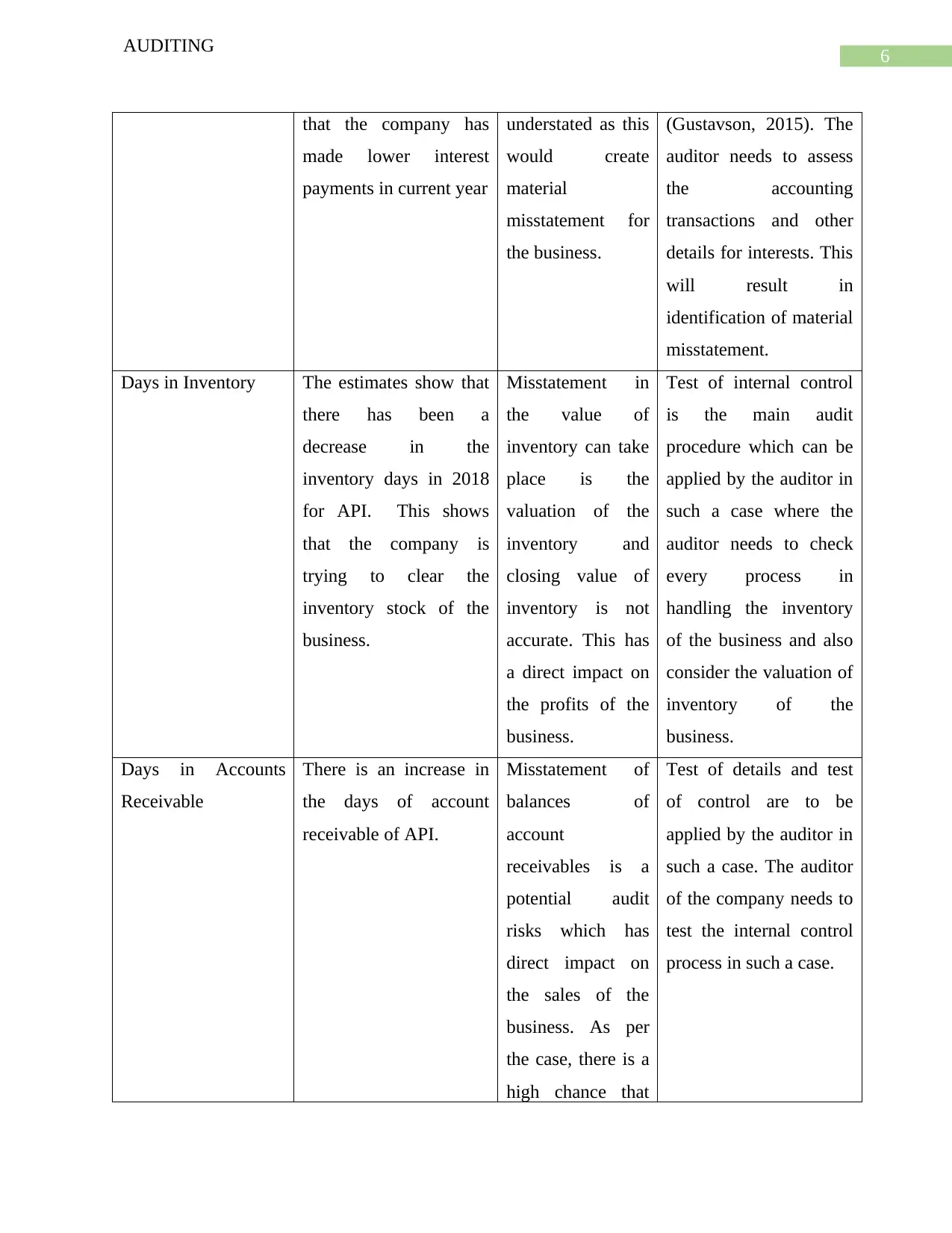
6
AUDITING
that the company has
made lower interest
payments in current year
understated as this
would create
material
misstatement for
the business.
(Gustavson, 2015). The
auditor needs to assess
the accounting
transactions and other
details for interests. This
will result in
identification of material
misstatement.
Days in Inventory The estimates show that
there has been a
decrease in the
inventory days in 2018
for API. This shows
that the company is
trying to clear the
inventory stock of the
business.
Misstatement in
the value of
inventory can take
place is the
valuation of the
inventory and
closing value of
inventory is not
accurate. This has
a direct impact on
the profits of the
business.
Test of internal control
is the main audit
procedure which can be
applied by the auditor in
such a case where the
auditor needs to check
every process in
handling the inventory
of the business and also
consider the valuation of
inventory of the
business.
Days in Accounts
Receivable
There is an increase in
the days of account
receivable of API.
Misstatement of
balances of
account
receivables is a
potential audit
risks which has
direct impact on
the sales of the
business. As per
the case, there is a
high chance that
Test of details and test
of control are to be
applied by the auditor in
such a case. The auditor
of the company needs to
test the internal control
process in such a case.
AUDITING
that the company has
made lower interest
payments in current year
understated as this
would create
material
misstatement for
the business.
(Gustavson, 2015). The
auditor needs to assess
the accounting
transactions and other
details for interests. This
will result in
identification of material
misstatement.
Days in Inventory The estimates show that
there has been a
decrease in the
inventory days in 2018
for API. This shows
that the company is
trying to clear the
inventory stock of the
business.
Misstatement in
the value of
inventory can take
place is the
valuation of the
inventory and
closing value of
inventory is not
accurate. This has
a direct impact on
the profits of the
business.
Test of internal control
is the main audit
procedure which can be
applied by the auditor in
such a case where the
auditor needs to check
every process in
handling the inventory
of the business and also
consider the valuation of
inventory of the
business.
Days in Accounts
Receivable
There is an increase in
the days of account
receivable of API.
Misstatement of
balances of
account
receivables is a
potential audit
risks which has
direct impact on
the sales of the
business. As per
the case, there is a
high chance that
Test of details and test
of control are to be
applied by the auditor in
such a case. The auditor
of the company needs to
test the internal control
process in such a case.
Paraphrase This Document
Need a fresh take? Get an instant paraphrase of this document with our AI Paraphraser
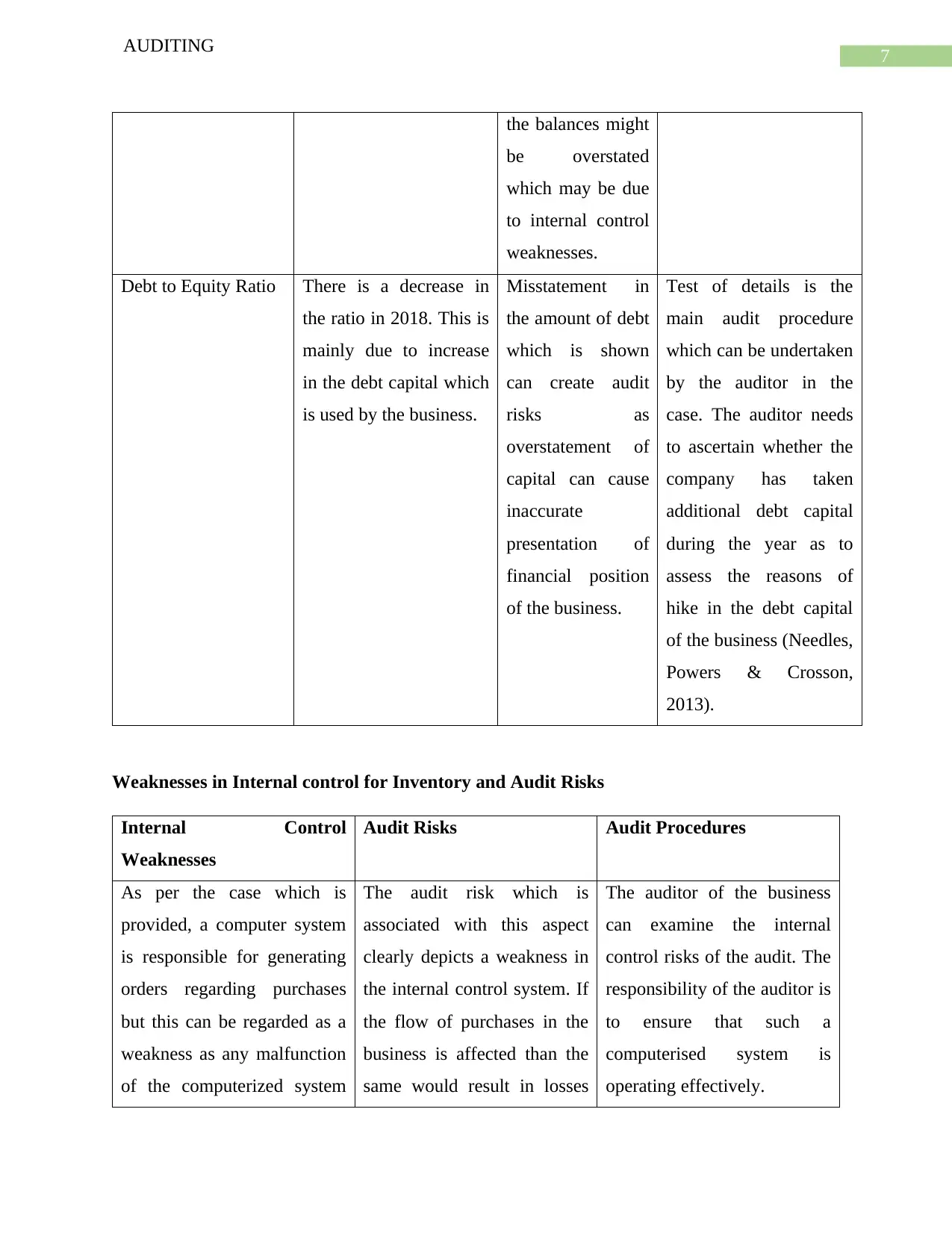
7
AUDITING
the balances might
be overstated
which may be due
to internal control
weaknesses.
Debt to Equity Ratio There is a decrease in
the ratio in 2018. This is
mainly due to increase
in the debt capital which
is used by the business.
Misstatement in
the amount of debt
which is shown
can create audit
risks as
overstatement of
capital can cause
inaccurate
presentation of
financial position
of the business.
Test of details is the
main audit procedure
which can be undertaken
by the auditor in the
case. The auditor needs
to ascertain whether the
company has taken
additional debt capital
during the year as to
assess the reasons of
hike in the debt capital
of the business (Needles,
Powers & Crosson,
2013).
Weaknesses in Internal control for Inventory and Audit Risks
Internal Control
Weaknesses
Audit Risks Audit Procedures
As per the case which is
provided, a computer system
is responsible for generating
orders regarding purchases
but this can be regarded as a
weakness as any malfunction
of the computerized system
The audit risk which is
associated with this aspect
clearly depicts a weakness in
the internal control system. If
the flow of purchases in the
business is affected than the
same would result in losses
The auditor of the business
can examine the internal
control risks of the audit. The
responsibility of the auditor is
to ensure that such a
computerised system is
operating effectively.
AUDITING
the balances might
be overstated
which may be due
to internal control
weaknesses.
Debt to Equity Ratio There is a decrease in
the ratio in 2018. This is
mainly due to increase
in the debt capital which
is used by the business.
Misstatement in
the amount of debt
which is shown
can create audit
risks as
overstatement of
capital can cause
inaccurate
presentation of
financial position
of the business.
Test of details is the
main audit procedure
which can be undertaken
by the auditor in the
case. The auditor needs
to ascertain whether the
company has taken
additional debt capital
during the year as to
assess the reasons of
hike in the debt capital
of the business (Needles,
Powers & Crosson,
2013).
Weaknesses in Internal control for Inventory and Audit Risks
Internal Control
Weaknesses
Audit Risks Audit Procedures
As per the case which is
provided, a computer system
is responsible for generating
orders regarding purchases
but this can be regarded as a
weakness as any malfunction
of the computerized system
The audit risk which is
associated with this aspect
clearly depicts a weakness in
the internal control system. If
the flow of purchases in the
business is affected than the
same would result in losses
The auditor of the business
can examine the internal
control risks of the audit. The
responsibility of the auditor is
to ensure that such a
computerised system is
operating effectively.

8
AUDITING
can jeopardise the entire
operations of the business.
for the business.
The management of the
company is dependent on the
computerised system only
which for production order as
any error. malfunction or
glitch can affect the entire
production process.
The weakness creates a risk
where the production process
and the same can impact the
operations of the business
adversely (Hassan, 2013).
There is also a risk of
overstatement and
understatement of the raw
material of the business.
This is related to control risks
which affects the business
and therefore the auditor
needs to rely on test of
control in the business. The
auditor needs to ensure that
the system which is
implemented by the
management of the company
is Up To Dated.
The management of API ltd is
also heavily dependent on
computer system for selection
of suppliers for raw materials
and record keeping of
finished goods. This
weakness can result in
selection of wrong suppliers
for the business.
This is also a risk which is
associated with control audit
and can affect the supply of
raw materials (Broberg,
Umans & Gerlofstig, 2013).
The cycle for raw materials
and finished goods is affected
as a result
The auditor in such a
situation needs to apply
substantive audit procedures
and also undertake test of
internal controls.
The account clerk has the
responsibility of filling copy
2 of the purchase order and
also has access to master file.
This is a weakness of the
internal control system.
An audit risk can develop if
the clerk engages in unethical
practices of manipulating
master file.
The auditor needs to apply
test of details where all
transactions of the master file
needs to be checked by the
auditor.
Access of the production
controller to password for
printing production and also
GRN printing can cause
The purchase of raw material
process and the production of
finished goods would be
adversely affected in such a
The main suggestion which
the auditor can provide to the
management is segregation of
duties for different printing
AUDITING
can jeopardise the entire
operations of the business.
for the business.
The management of the
company is dependent on the
computerised system only
which for production order as
any error. malfunction or
glitch can affect the entire
production process.
The weakness creates a risk
where the production process
and the same can impact the
operations of the business
adversely (Hassan, 2013).
There is also a risk of
overstatement and
understatement of the raw
material of the business.
This is related to control risks
which affects the business
and therefore the auditor
needs to rely on test of
control in the business. The
auditor needs to ensure that
the system which is
implemented by the
management of the company
is Up To Dated.
The management of API ltd is
also heavily dependent on
computer system for selection
of suppliers for raw materials
and record keeping of
finished goods. This
weakness can result in
selection of wrong suppliers
for the business.
This is also a risk which is
associated with control audit
and can affect the supply of
raw materials (Broberg,
Umans & Gerlofstig, 2013).
The cycle for raw materials
and finished goods is affected
as a result
The auditor in such a
situation needs to apply
substantive audit procedures
and also undertake test of
internal controls.
The account clerk has the
responsibility of filling copy
2 of the purchase order and
also has access to master file.
This is a weakness of the
internal control system.
An audit risk can develop if
the clerk engages in unethical
practices of manipulating
master file.
The auditor needs to apply
test of details where all
transactions of the master file
needs to be checked by the
auditor.
Access of the production
controller to password for
printing production and also
GRN printing can cause
The purchase of raw material
process and the production of
finished goods would be
adversely affected in such a
The main suggestion which
the auditor can provide to the
management is segregation of
duties for different printing
⊘ This is a preview!⊘
Do you want full access?
Subscribe today to unlock all pages.

Trusted by 1+ million students worldwide
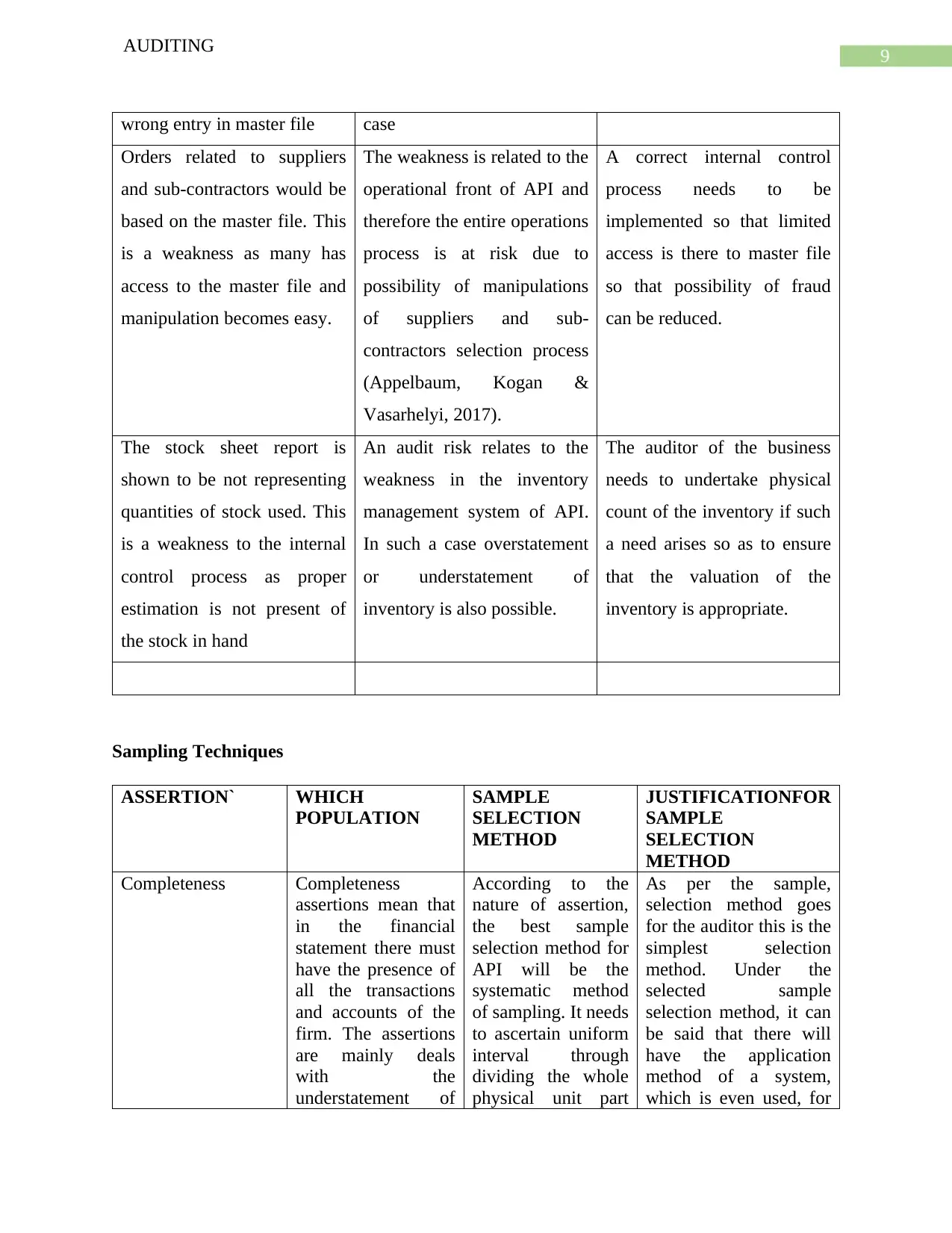
9
AUDITING
wrong entry in master file case
Orders related to suppliers
and sub-contractors would be
based on the master file. This
is a weakness as many has
access to the master file and
manipulation becomes easy.
The weakness is related to the
operational front of API and
therefore the entire operations
process is at risk due to
possibility of manipulations
of suppliers and sub-
contractors selection process
(Appelbaum, Kogan &
Vasarhelyi, 2017).
A correct internal control
process needs to be
implemented so that limited
access is there to master file
so that possibility of fraud
can be reduced.
The stock sheet report is
shown to be not representing
quantities of stock used. This
is a weakness to the internal
control process as proper
estimation is not present of
the stock in hand
An audit risk relates to the
weakness in the inventory
management system of API.
In such a case overstatement
or understatement of
inventory is also possible.
The auditor of the business
needs to undertake physical
count of the inventory if such
a need arises so as to ensure
that the valuation of the
inventory is appropriate.
Sampling Techniques
ASSERTION` WHICH
POPULATION
SAMPLE
SELECTION
METHOD
JUSTIFICATIONFOR
SAMPLE
SELECTION
METHOD
Completeness Completeness
assertions mean that
in the financial
statement there must
have the presence of
all the transactions
and accounts of the
firm. The assertions
are mainly deals
with the
understatement of
According to the
nature of assertion,
the best sample
selection method for
API will be the
systematic method
of sampling. It needs
to ascertain uniform
interval through
dividing the whole
physical unit part
As per the sample,
selection method goes
for the auditor this is the
simplest selection
method. Under the
selected sample
selection method, it can
be said that there will
have the application
method of a system,
which is even used, for
AUDITING
wrong entry in master file case
Orders related to suppliers
and sub-contractors would be
based on the master file. This
is a weakness as many has
access to the master file and
manipulation becomes easy.
The weakness is related to the
operational front of API and
therefore the entire operations
process is at risk due to
possibility of manipulations
of suppliers and sub-
contractors selection process
(Appelbaum, Kogan &
Vasarhelyi, 2017).
A correct internal control
process needs to be
implemented so that limited
access is there to master file
so that possibility of fraud
can be reduced.
The stock sheet report is
shown to be not representing
quantities of stock used. This
is a weakness to the internal
control process as proper
estimation is not present of
the stock in hand
An audit risk relates to the
weakness in the inventory
management system of API.
In such a case overstatement
or understatement of
inventory is also possible.
The auditor of the business
needs to undertake physical
count of the inventory if such
a need arises so as to ensure
that the valuation of the
inventory is appropriate.
Sampling Techniques
ASSERTION` WHICH
POPULATION
SAMPLE
SELECTION
METHOD
JUSTIFICATIONFOR
SAMPLE
SELECTION
METHOD
Completeness Completeness
assertions mean that
in the financial
statement there must
have the presence of
all the transactions
and accounts of the
firm. The assertions
are mainly deals
with the
understatement of
According to the
nature of assertion,
the best sample
selection method for
API will be the
systematic method
of sampling. It needs
to ascertain uniform
interval through
dividing the whole
physical unit part
As per the sample,
selection method goes
for the auditor this is the
simplest selection
method. Under the
selected sample
selection method, it can
be said that there will
have the application
method of a system,
which is even used, for
Paraphrase This Document
Need a fresh take? Get an instant paraphrase of this document with our AI Paraphraser
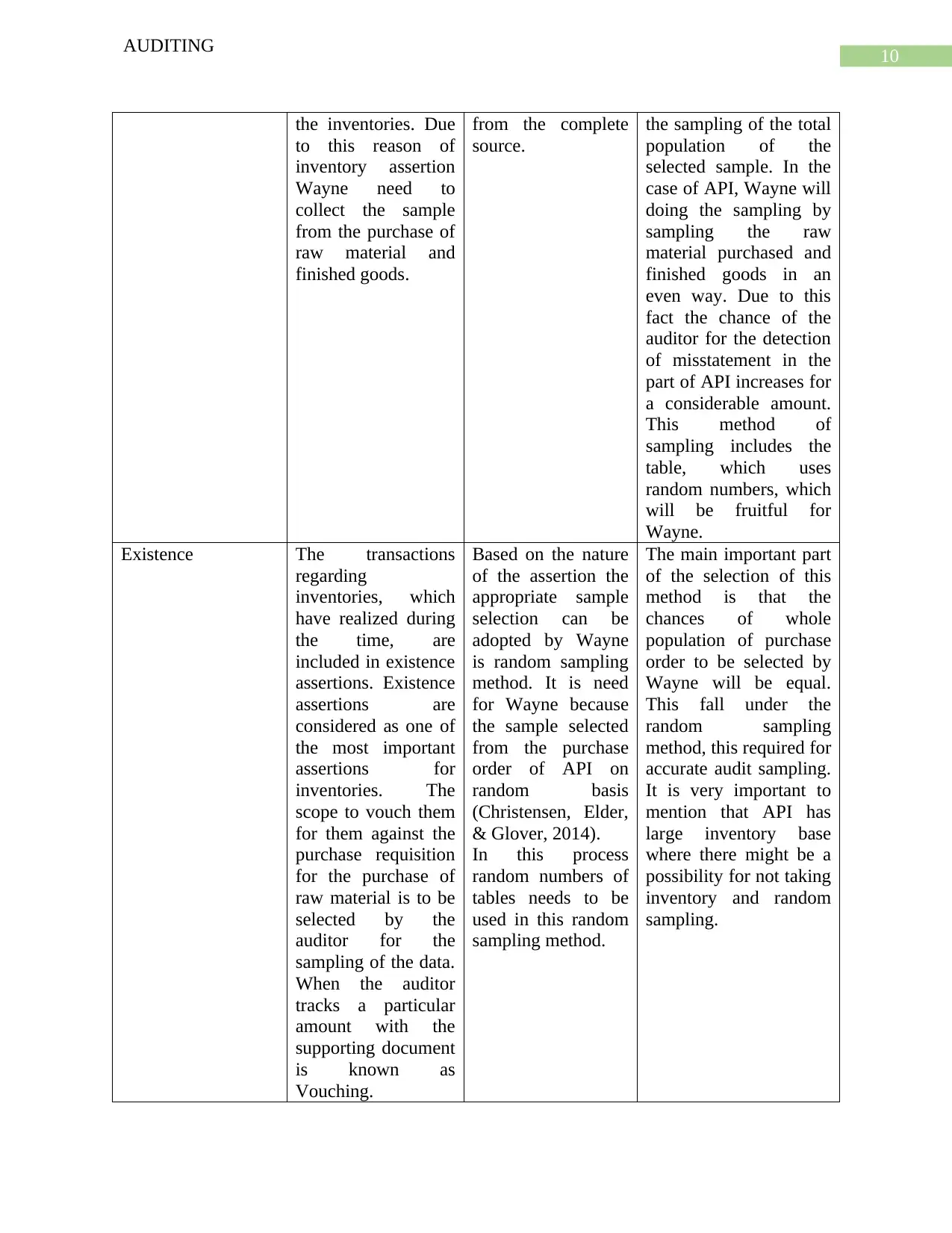
10
AUDITING
the inventories. Due
to this reason of
inventory assertion
Wayne need to
collect the sample
from the purchase of
raw material and
finished goods.
from the complete
source.
the sampling of the total
population of the
selected sample. In the
case of API, Wayne will
doing the sampling by
sampling the raw
material purchased and
finished goods in an
even way. Due to this
fact the chance of the
auditor for the detection
of misstatement in the
part of API increases for
a considerable amount.
This method of
sampling includes the
table, which uses
random numbers, which
will be fruitful for
Wayne.
Existence The transactions
regarding
inventories, which
have realized during
the time, are
included in existence
assertions. Existence
assertions are
considered as one of
the most important
assertions for
inventories. The
scope to vouch them
for them against the
purchase requisition
for the purchase of
raw material is to be
selected by the
auditor for the
sampling of the data.
When the auditor
tracks a particular
amount with the
supporting document
is known as
Vouching.
Based on the nature
of the assertion the
appropriate sample
selection can be
adopted by Wayne
is random sampling
method. It is need
for Wayne because
the sample selected
from the purchase
order of API on
random basis
(Christensen, Elder,
& Glover, 2014).
In this process
random numbers of
tables needs to be
used in this random
sampling method.
The main important part
of the selection of this
method is that the
chances of whole
population of purchase
order to be selected by
Wayne will be equal.
This fall under the
random sampling
method, this required for
accurate audit sampling.
It is very important to
mention that API has
large inventory base
where there might be a
possibility for not taking
inventory and random
sampling.
AUDITING
the inventories. Due
to this reason of
inventory assertion
Wayne need to
collect the sample
from the purchase of
raw material and
finished goods.
from the complete
source.
the sampling of the total
population of the
selected sample. In the
case of API, Wayne will
doing the sampling by
sampling the raw
material purchased and
finished goods in an
even way. Due to this
fact the chance of the
auditor for the detection
of misstatement in the
part of API increases for
a considerable amount.
This method of
sampling includes the
table, which uses
random numbers, which
will be fruitful for
Wayne.
Existence The transactions
regarding
inventories, which
have realized during
the time, are
included in existence
assertions. Existence
assertions are
considered as one of
the most important
assertions for
inventories. The
scope to vouch them
for them against the
purchase requisition
for the purchase of
raw material is to be
selected by the
auditor for the
sampling of the data.
When the auditor
tracks a particular
amount with the
supporting document
is known as
Vouching.
Based on the nature
of the assertion the
appropriate sample
selection can be
adopted by Wayne
is random sampling
method. It is need
for Wayne because
the sample selected
from the purchase
order of API on
random basis
(Christensen, Elder,
& Glover, 2014).
In this process
random numbers of
tables needs to be
used in this random
sampling method.
The main important part
of the selection of this
method is that the
chances of whole
population of purchase
order to be selected by
Wayne will be equal.
This fall under the
random sampling
method, this required for
accurate audit sampling.
It is very important to
mention that API has
large inventory base
where there might be a
possibility for not taking
inventory and random
sampling.
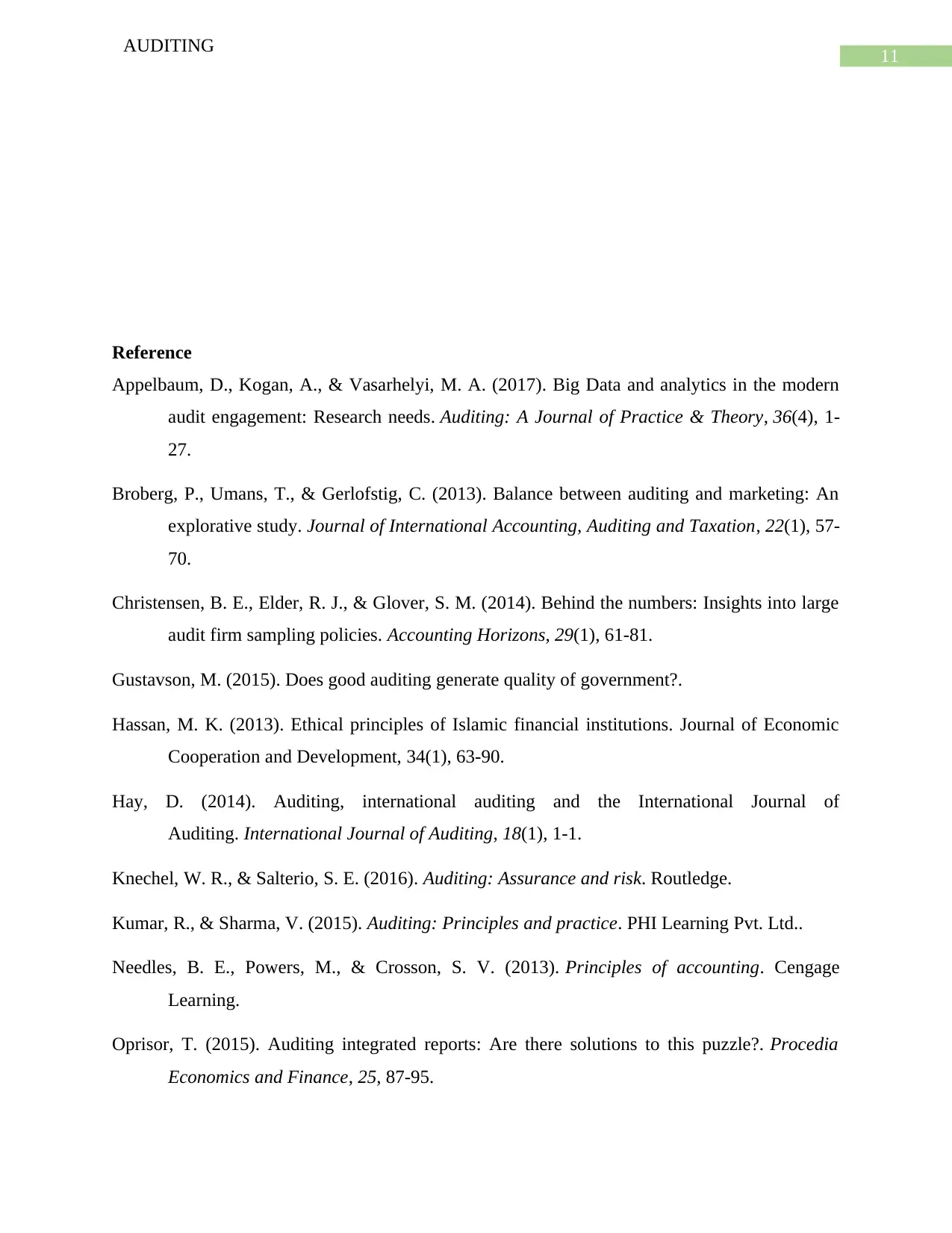
11
AUDITING
Reference
Appelbaum, D., Kogan, A., & Vasarhelyi, M. A. (2017). Big Data and analytics in the modern
audit engagement: Research needs. Auditing: A Journal of Practice & Theory, 36(4), 1-
27.
Broberg, P., Umans, T., & Gerlofstig, C. (2013). Balance between auditing and marketing: An
explorative study. Journal of International Accounting, Auditing and Taxation, 22(1), 57-
70.
Christensen, B. E., Elder, R. J., & Glover, S. M. (2014). Behind the numbers: Insights into large
audit firm sampling policies. Accounting Horizons, 29(1), 61-81.
Gustavson, M. (2015). Does good auditing generate quality of government?.
Hassan, M. K. (2013). Ethical principles of Islamic financial institutions. Journal of Economic
Cooperation and Development, 34(1), 63-90.
Hay, D. (2014). Auditing, international auditing and the International Journal of
Auditing. International Journal of Auditing, 18(1), 1-1.
Knechel, W. R., & Salterio, S. E. (2016). Auditing: Assurance and risk. Routledge.
Kumar, R., & Sharma, V. (2015). Auditing: Principles and practice. PHI Learning Pvt. Ltd..
Needles, B. E., Powers, M., & Crosson, S. V. (2013). Principles of accounting. Cengage
Learning.
Oprisor, T. (2015). Auditing integrated reports: Are there solutions to this puzzle?. Procedia
Economics and Finance, 25, 87-95.
AUDITING
Reference
Appelbaum, D., Kogan, A., & Vasarhelyi, M. A. (2017). Big Data and analytics in the modern
audit engagement: Research needs. Auditing: A Journal of Practice & Theory, 36(4), 1-
27.
Broberg, P., Umans, T., & Gerlofstig, C. (2013). Balance between auditing and marketing: An
explorative study. Journal of International Accounting, Auditing and Taxation, 22(1), 57-
70.
Christensen, B. E., Elder, R. J., & Glover, S. M. (2014). Behind the numbers: Insights into large
audit firm sampling policies. Accounting Horizons, 29(1), 61-81.
Gustavson, M. (2015). Does good auditing generate quality of government?.
Hassan, M. K. (2013). Ethical principles of Islamic financial institutions. Journal of Economic
Cooperation and Development, 34(1), 63-90.
Hay, D. (2014). Auditing, international auditing and the International Journal of
Auditing. International Journal of Auditing, 18(1), 1-1.
Knechel, W. R., & Salterio, S. E. (2016). Auditing: Assurance and risk. Routledge.
Kumar, R., & Sharma, V. (2015). Auditing: Principles and practice. PHI Learning Pvt. Ltd..
Needles, B. E., Powers, M., & Crosson, S. V. (2013). Principles of accounting. Cengage
Learning.
Oprisor, T. (2015). Auditing integrated reports: Are there solutions to this puzzle?. Procedia
Economics and Finance, 25, 87-95.
⊘ This is a preview!⊘
Do you want full access?
Subscribe today to unlock all pages.

Trusted by 1+ million students worldwide
1 out of 13